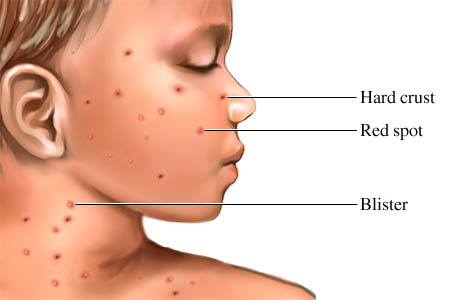Chickenpox (infection) - symptoms, causes and treatment

What is Chickenpox
Chickenpox - a common childhood illness that results from INFECTION with the varicella-zoster VIRUS, a member of the herpesvirus family. Chickenpox, also called varicella disease, is highly contagious, spreading through direct contact and exposure to airborne droplets containing the varicella-zoster virus. The INCUBATION PERIOD (time from exposure to illness) is 10 to 21 days.
Symptoms of Chickenpox and Diagnostic Path
The first symptoms are general and include FEVER, HEADACHE, loss of APPETITE, and sometimes NAUSEA and VOMITING. Within two days the characteristic pox emerge. These fluid-filled blisters cover the body and sometimes even occur within the MOUTH, on the surface and sometimes the inside of the eyelids, and in the VAGINA. The blisters itch intensely. In two or three days the fluid within the blisters oozes out and a crust forms, after which the itching subsides. However, new batches of blisters may continue to emerge in clusters for three to five days after the first outbreak.
Diagnosis is straightforward as the pox are characteristic and the illness is so highly contagious that it affects large numbers of people. Many health-care providers do not want to see people who are likely to have chickenpox because of the contagiousness and because treatment is supportive, not therapeutic. The person is contagious from two days before the onset of symptoms until all the pox crust over.
Chickenpox: Treatment Options and Outlook
Most people do not require treatment other than supportive care to improve comfort. Such care may include
- calamine lotion applied to the blisters to relieve itching
- oral ANTIHISTAMINE MEDICATION to relieve itching
- acetaminophen or NONSTEROIDAL ANTI-INFLAMMATORY DRUGS (NSAIDS) such as ibuprofen to relieve headache, fever, and general discomfort
- tepid baths with oatmeal in the water to relieve itching
Isolation is important until all the pox have blistered. Schools may require children to remain home until the crusts are no longer apparent. Most people recover and are able to return to normal activities within 7 to10 days. The pox heal without scarring unless they become infected, which may happen with excessive scratching.
Chickenpox and Reye’s syndrome
Do not give aspirin to anyone who has chickenpox, as doing so creates the risk for developing REYE’S SYNDROME. Reye’s syndrome is a serious neurologic condition that can be fatal.
ANTIVIRAL MEDICATIONS can significantly lessen the severity and length of illness when taken within 24 hours of the first pox. However, doctors typically reserve antiviral medications for people at risk for severe illness-infants under one year of age, pregnant women, and people who are IMMUNOCOMPROMISED-because the normal course of illness is short and has very low risk for significant complications. The most common complication of chickenpox is bacterial infection of the pox that results from scratching, which introduces BACTERIA into the blisters. Complications that are rare though possible include ENCEPHALITIS, PNEUMONIA, and REYE’S SYNDROME.
The varicella-zoster virus remains in the body after the illness of chickenpox runs its course, retreating to the NERVE roots where it apparently enters a stage of dormancy. In 90 percent of people the virus never re-emerges; however, in about 10 percent of people the virus causes HERPES ZOSTER (shingles) years to decades after chickenpox.
Risk Factors and Preventive Measures
Exposure to the varicella-zoster virus is the only risk factor for chickenpox. It is very difficult to avoid exposure because the MODES OF TRANSMISSION are multiple. As well, the extremely contagious nature of the infection coupled with the extended incubation period means exposure often occurs before people realize they are ill; outbreaks of chickenpox are typically widespread. A VACCINE for chickenpox is part of the routine IMMUNIZATION schedule for children in the United States. The vaccine prevents chickenpox in about 85 percent of people who receive it and significantly reduces the severity and length of illness in those who acquire the infection.
See also BLISTER; CHILDHOOD DISEASES; MEASLES; MUMPS; OCULAR HERPES ZOSTER; PREVENTIVE HEALTH CARE AND IMMUNIZATION; RUBELLA; SNEEZE/COUGH ETIQUETTE.
Open discussion on the topic Chickenpox (infection) - symptoms, causes and treatment
Similar interests
- Casino Non Aams
- Nuovi Casino
- Casinos Not On Gamstop
- UK Casinos Not On Gamstop
- Casinos Not On Gamstop
- UK Casinos Not On Gamstop
- Casino Non Aams Italia
- Slot Sites Not On Gamstop
- Meilleur Casino En Ligne
- Non Gamstop Casino Sites UK
- Meilleur Casino En Ligne
- Casino En Ligne France
- Best Non Gamstop Casinos
- Casinos Not On Gamstop
- UK Casino Not On Gamstop
- Casinos Not Signed Up To Gamstop
- Best Slot Sites UK
- Non Gamstop Casino Sites UK
- Online Casinos Nederland
- Online Casinos Nederland
- Casinos Not On Gamstop
- Best New Uk Casinos Not On Gamstop
- Casino Non Aams
- Non Gamstop Casinos UK
- Migliori Siti Casino Non Aams
- Bitcoin Casinos
- Sites De Paris Sportifs Belgique
- Bookmaker Non Aams
- Casino En Ligne
- Casino Français Sans Kyc
- Casino Nouveau En Ligne
- No Kyc Casino